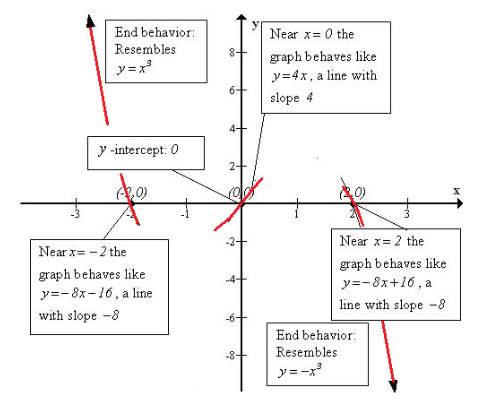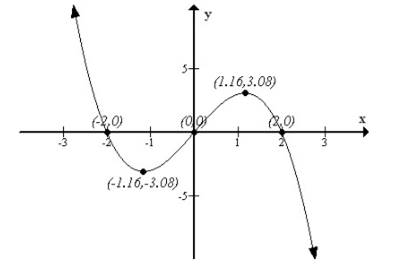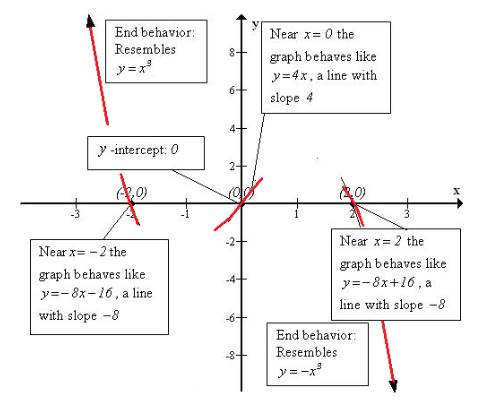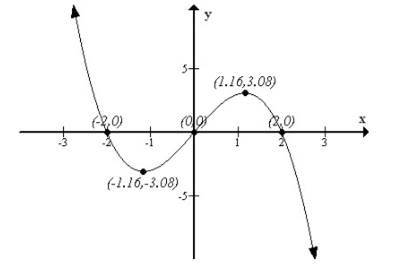
Concept explainers
To analyze: the given polynomial function
Answer to Problem 95AYU


Explanation of Solution
Given:
Calculation:
Let us consider the function
Polynomial function
Step1: Determine the end behavior of the graph of the function.
Expand the polynomial to write it in the form
The polynomial function f is of degree 3. The graph of f behaves like
Step2: find the x -and y -intercepts of the graph of the function
The y -intercept is
The x -intercepts are -2, 0, and 2.
Step3: Determine the zeros of the function and their multiplicity. Use this information to determine whether the graph crosses or touches the x -axis at each x -intercept.
The zeros offare -2, 0 and 2. The zero -2 is a zero of multiplicity l , so the graph of f crosses the x -axis at
Step 4: Determine the maximum number of turning points on the graph of the function. While the polynomial function is of degree 3 (step1), the graph of the function will have at most
Step5: Determine the behavior of the graph of f near each x -intercept.
The two x -intercepts are -2,0 and 2.
Step 6: Put all the information from Steps 1 through 5 together to obtain the graph of f Figure 1(a) illustrates the information obtained from Steps 1 through 5. Evaluatef at -1.16, 1.16 to help establish the scale on the y -axis. The graph of f is given in Figure1(b).


Conclusion:
Therefore, the polynomial function
Chapter 4 Solutions
Precalculus
Additional Math Textbook Solutions
Calculus: Early Transcendentals (2nd Edition)
Algebra and Trigonometry (6th Edition)
University Calculus: Early Transcendentals (4th Edition)
A Problem Solving Approach To Mathematics For Elementary School Teachers (13th Edition)
A First Course in Probability (10th Edition)
Pre-Algebra Student Edition
- Let the region R be the area enclosed by the function f(x)= = 3x² and g(x) = 4x. If the region R is the base of a solid such that each cross section perpendicular to the x-axis is an isosceles right triangle with a leg in the region R, find the volume of the solid. You may use a calculator and round to the nearest thousandth. y 11 10 9 00 8 7 9 5 4 3 2 1 -1 -1 x 1 2arrow_forwardLet the region R be the area enclosed by the function f(x) = ex — 1, the horizontal line y = -4 and the vertical lines x = 0 and x = 3. Find the volume of the solid generated when the region R is revolved about the line y = -4. You may use a calculator and round to the nearest thousandth. 20 15 10 5 y I I I | I + -1.5 -1 -0.5 0.5 1 1.5 2 2.5 3 -5 I -10 -15 I + I I T I I + -20 I + -25 I I I -30 I 3.5 4 xarrow_forwardplease show all the workarrow_forward
 Calculus: Early TranscendentalsCalculusISBN:9781285741550Author:James StewartPublisher:Cengage Learning
Calculus: Early TranscendentalsCalculusISBN:9781285741550Author:James StewartPublisher:Cengage Learning Thomas' Calculus (14th Edition)CalculusISBN:9780134438986Author:Joel R. Hass, Christopher E. Heil, Maurice D. WeirPublisher:PEARSON
Thomas' Calculus (14th Edition)CalculusISBN:9780134438986Author:Joel R. Hass, Christopher E. Heil, Maurice D. WeirPublisher:PEARSON Calculus: Early Transcendentals (3rd Edition)CalculusISBN:9780134763644Author:William L. Briggs, Lyle Cochran, Bernard Gillett, Eric SchulzPublisher:PEARSON
Calculus: Early Transcendentals (3rd Edition)CalculusISBN:9780134763644Author:William L. Briggs, Lyle Cochran, Bernard Gillett, Eric SchulzPublisher:PEARSON Calculus: Early TranscendentalsCalculusISBN:9781319050740Author:Jon Rogawski, Colin Adams, Robert FranzosaPublisher:W. H. Freeman
Calculus: Early TranscendentalsCalculusISBN:9781319050740Author:Jon Rogawski, Colin Adams, Robert FranzosaPublisher:W. H. Freeman
 Calculus: Early Transcendental FunctionsCalculusISBN:9781337552516Author:Ron Larson, Bruce H. EdwardsPublisher:Cengage Learning
Calculus: Early Transcendental FunctionsCalculusISBN:9781337552516Author:Ron Larson, Bruce H. EdwardsPublisher:Cengage Learning





